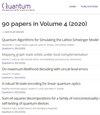Exact Model Reduction for Continuous-Time Open Quantum Dynamics
IF 5.1
2区 物理与天体物理
Q1 PHYSICS, MULTIDISCIPLINARY
引用次数: 0
Abstract
We consider finite-dimensional many-body quantum systems described by time-independent Hamiltonians and Markovian master equations, and present a systematic method for constructing smaller-dimensional, reduced models that $exactly$ reproduce the time evolution of a set of initial conditions or observables of interest. Our approach exploits Krylov operator spaces and their extension to operator algebras, and may be used to obtain reduced linear models of minimal dimension, well-suited for simulation on classical computers, or reduced quantum models that preserve the structural constraints of physically admissible quantum dynamics, as required for simulation on quantum computers. Notably, we prove that the reduced quantum-dynamical generator is still in Lindblad form. By introducing a new type of $\textit{observable-dependent symmetries}$, we show that our method provides a non-trivial generalization of techniques that leverage symmetries, unlocking new reduction opportunities. We quantitatively benchmark our method on paradigmatic open many-body systems of relevance to condensed-matter and quantum-information physics. In particular, we demonstrate how our reduced models can quantitatively describe decoherence dynamics in central-spin systems coupled to structured environments, magnetization transport in boundary-driven dissipative spin chains, and unwanted error dynamics on information encoded in a noiseless quantum code.连续时间开放量子动力学的精确模型简化
我们考虑由时间无关的哈密顿量和马尔可夫主方程描述的有限维多体量子系统,并提出了一种系统的方法来构建更小维的简化模型,该模型$exactly$再现了一组初始条件或感兴趣的可观测值的时间演化。我们的方法利用了Krylov算子空间及其对算子代数的扩展,并可用于获得最小维的简化线性模型,非常适合在经典计算机上模拟,或简化量子模型,保留物理上可接受的量子动力学的结构约束,如在量子计算机上模拟所需要的。值得注意的是,我们证明了简化后的量子动力发生器仍然是Lindblad形式。通过引入一种新型的$\textit{observable-dependent symmetries}$,我们表明我们的方法提供了利用对称性的技术的非平凡泛化,释放了新的约简机会。我们在与凝聚态物质和量子信息物理相关的范式开放多体系统上对我们的方法进行了定量基准测试。特别是,我们展示了我们的简化模型如何定量描述与结构环境耦合的中心自旋系统的退相干动力学,边界驱动的耗散自旋链中的磁化输运,以及在无噪声量子编码中编码信息的不必要的误差动力学。
本文章由计算机程序翻译,如有差异,请以英文原文为准。
求助全文
约1分钟内获得全文
求助全文
来源期刊

Quantum
Physics and Astronomy-Physics and Astronomy (miscellaneous)
CiteScore
9.20
自引率
10.90%
发文量
241
审稿时长
16 weeks
期刊介绍:
Quantum is an open-access peer-reviewed journal for quantum science and related fields. Quantum is non-profit and community-run: an effort by researchers and for researchers to make science more open and publishing more transparent and efficient.
 求助内容:
求助内容: 应助结果提醒方式:
应助结果提醒方式:


